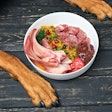
Eight trends influence the pet food industry worldwide, said Arturo Valdez, senior client officer for IPSOS Mexico, during the opening presentation of Foro Mascotas 2019 in Guadalajara, Mexico on May 29. Deciding which of those pet food trends to follow allows brands to differentiate themselves by appealing to specific pet owners’ demands.
Pet owners worldwide, especially younger ones, increasingly demand that their dogs, cats and other pets’ diets follow these trends:
1. Natural/organic
Younger groups especially understand that natural depends on the ingredients, said Valdez [translated from Spanish].
In general, less is more when it comes to natural pet food, he said. The few ingredients and the simpler they are, the better. DoGift is an example in Mexico of the natural pet food trend. DoGift is made with organic ingredients grown in Mexico.
2. Free-from claims
People are more likely to read labels now, Valdez said.
Just as pet owners want to know that natural ingredients are in their animals’ diets, they want to know that certain ingredients aren’t, he said. The demand for pet foods without specific ingredients can have important health reasons, such as avoiding allergies, or can be based in a person’s ethics, such as animal advocates who choose vegetarianism.
On the other hand, many pet owners don’t want artificial ingredients, GMOs, synthetic preservatives or similar substances, because of beliefs that these ingredients are universally harmful. Even the name of a common ingredient, such as vitamin C is listed on an ingredient deck as ascorbic acid, can turn off some consumers, who may not realize that even oranges are made from chemicals.
Valdez mentioned Treat Taster Pack as an example of the free-from claims trend in Mexico. Treat Taster Pack markets their products as containing no wheat, no gluten, no salt and no sugar.
3. Experiential consumption
Millennials seek experiences over material goods, Valdez said.
The social media network Instagram provides an example of this. On Instagram, people share their histories of experiences. In the modern version of keeping up with the Joneses, people compete for social standing based on what they’ve done, as opposed to what they own.
In human cuisine, foodie culture emphasizes not just the taste and nutrition of food, but the experience of eating it. In pet food, this translates to giving pets a stimulating dining experience, that may well serve more to boost the human’s ego than the pet’s nutrition.
For example, Just Food for Dogs prepares fresh dog food and treats in an open kitchen where pet owners can watch as chefs prepare dog diets in the same manner as a human restaurant.
In Mexico, HAR Alimento positions their brand to follow the experiential consumption trend, Valdez said.
4. Reducing meat protein
In IPSOS’ Global Advisor survey, 75% of pet owners self-identified as omnivores. However, omnivores face a dilemma. Various motivations from environmentalism to animal welfare to health concerns push people away from conventional livestock, especially cattle.
People want to reduce animal protein for health and environmental reasons, Valdez said.
Pet owners turn to alternative protein sources to replace warm-blooded flesh. Beans, soy, insects and algae now provide protein, and more importantly its constituent amino acids. In Mexico, QRILL Pet uses krill as a novel pet food protein. Krill are tiny aquatic crustaceans.
5. Healthy snacks
Although snacks are generally seen as unhealthy, nutritious options are starting to appear, such as protein bars, said Valdez. In the Mexican pet food market, Don Paletto offers Heladog a frozen yogurt dog treat made without sugar and providing probiotic benefits.
6. Convenience
As access to the internet becomes a global reality, more people use e-commerce to streamline their shopping. In IPSOS’ Global Survey, 10 % of pet food buyers reported buying online only. Another 24% shop principally online and 67% occasionally, Valdez said.
7. Concern for the environment
Pet owners increasingly consider the environmental and social ramifications of pet food production, as people realize that without stable ecosystem and human rights protection, our global economy will collapse.
However, this concern for the long-term prosperity of humanity takes a back seat to short-term financial savings in much of the world, said Valdez.
Although most IPSOS Global Trends 2016 survey participants stated that they wanted sustainable products, in developed economies, cost often takes precedence over environment, he said.
8. Premium products
Dogs, cats and other pets form part of people’s families now, as opposed to being just burglar alarms and mouse-catchers. Pet owners often want to give their pets high quality, premium food, just as they would care for a child’s diet. This premiumization of pet food takes many forms: packaging, ingredients, marketing and other aspects, Valdez said.
Premiumization is relatively simple in food and beverage, since consumers understand that differences exist between ingredient quality, he said.



















